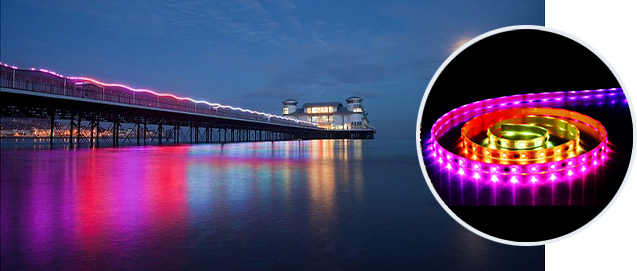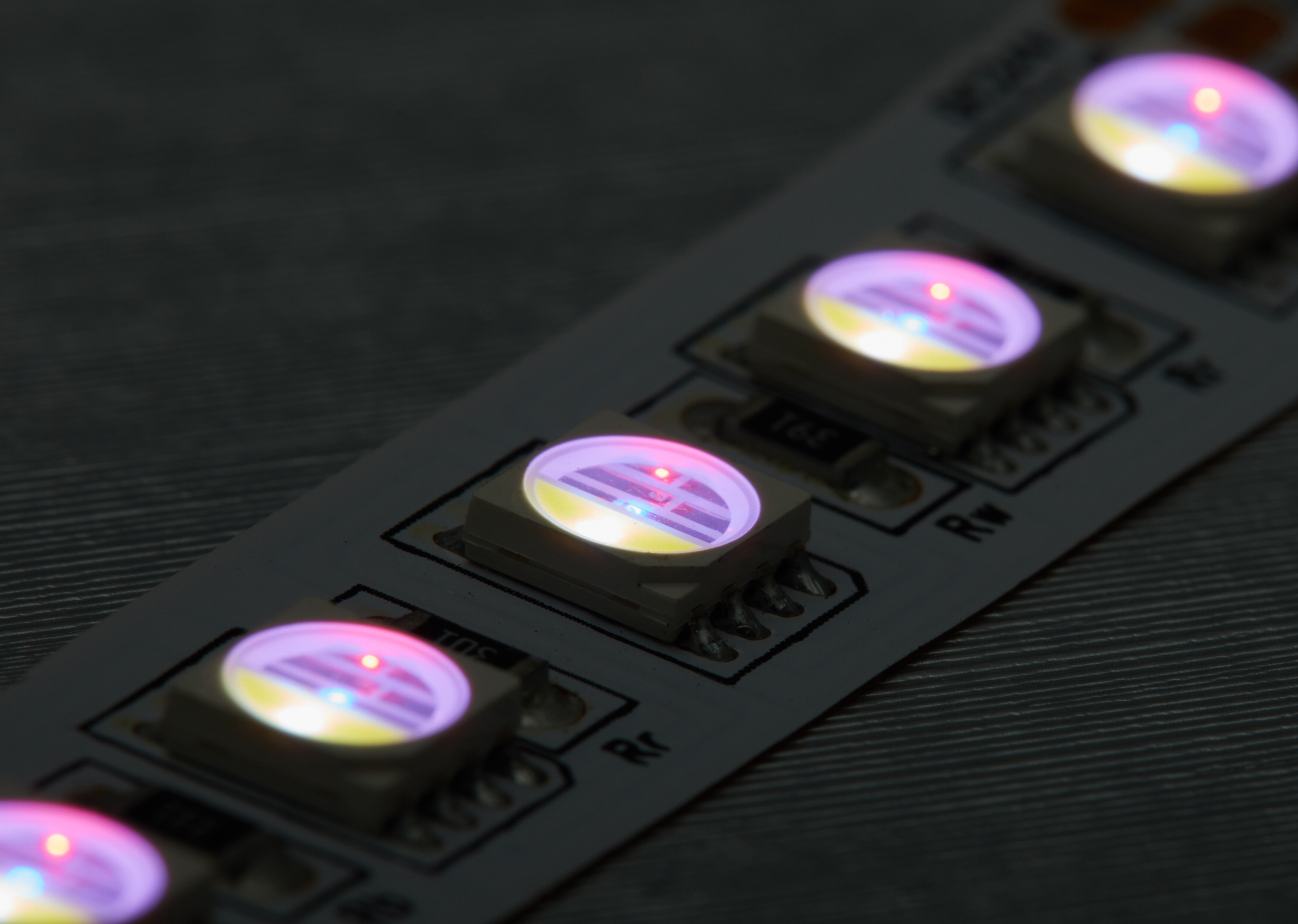Views: 0 Author: Site Editor Publish Time: 2025-03-14 Origin: Site
Neon or LED strip lights – which is better? This common debate has many lighting enthusiasts divided. Choosing the right lighting is essential for both style and functionality. In this post, we’ll discuss the differences between neon and LED strip lights, helping you decide which is the best fit for your needs.

Neon lights are iconic, providing a classic glow. Traditional neon lighting uses glass tubes filled with gas. When electric current passes through the gas, it glows, producing the signature bright colors. This glow is often associated with signs, bars, and artistic displays.
Glass tubes filled with gas (usually neon or argon).
Electric current excites the gas, causing it to emit light.
The glow produced is smooth and continuous.
Aesthetic Appeal: Offers a timeless, vintage feel.
Bold Visibility: Great for high-impact displays and signage.
Unique Glow: The glowing effect is unmatched by other lighting types.
Fragility: Glass tubes can easily break.
Higher Energy Consumption: Less energy-efficient compared to LED options.
Limited Flexibility: Difficult to bend or shape for creative installations.
LED strip lights are flexible strips embedded with small LED bulbs. These strips offer a modern, sleek look and are often used for a variety of applications, from under-cabinet lighting to accent lights for artwork.
Flexible Circuit Boards: Strips can be bent and cut to fit specific spaces.
Visible LED Points: Each section of the strip contains multiple LEDs, providing uniform light.
Energy Efficient: Consumes far less electricity compared to neon lights.
Customizable: Can be cut and adjusted to fit any space or shape.
Durability: Resistant to impacts and lasts longer than traditional neon lights.
Visible LED Points: The visible light points can be less seamless than the smooth glow of neon.
Setup: While easy to install, it may require proper wiring and power sources.

Neon lights are known for their smooth, continuous glow. This gives them a classic and artistic feel, perfect for signs or decorative displays. The iconic neon glow is hard to beat, especially in high-visibility applications like storefronts or advertisements.
On the other hand, LED strip lights consist of visible LED points arranged along a flexible strip. While they provide a modern, sleek look, the light isn’t as seamless as neon. LED strips are ideal for highlighting specific areas or creating accent lighting in contemporary spaces.
Neon Lights: Classic, smooth glow; perfect for artistic displays and signage.
LED Strip Lights: More modern and functional; great for accent and task lighting.
LED strip lights are often favored for modern interiors, while neon lights suit vintage or retro aesthetics.
One of the main concerns with traditional neon lights is their fragility. The glass tubes can easily break, making them less practical in certain settings. However, modern LED neon flex lights are more durable and flexible, offering a similar glow without the fragility of glass.
LED strip lights are designed for durability. They are resistant to impacts, and their flexible nature makes them easy to install in various environments. They last longer than traditional neon lights, with many models offering up to 50,000 hours of use.
Neon Lights: Less durable, with a lifespan of about 15,000 to 25,000 hours.
LED Strip Lights: Much longer lifespan, ranging from 30,000 to 50,000 hours or more.
Traditional neon lights consume a lot of power due to the gas-filled glass tubes. They are not as energy-efficient as LED options. Modern LED neon flex lights are more efficient, but they still consume more energy than LED strips.
LED strip lights are incredibly energy-efficient. They use less electricity to produce the same, or even brighter, output. Over time, LED strips can save a significant amount on electricity bills compared to both neon and LED neon lights.
Neon Lights: High energy consumption, especially in traditional neon forms.
LED Strip Lights: Much more energy-efficient, saving on electricity costs in the long run.
For anyone concerned about energy bills, LED strip lights are the better choice.
Installing traditional neon lights can be tricky. The glass tubes are fragile, so handling them with care is essential. You also need special equipment, like transformers, to power the lights. Due to the complexity, many people choose professional installation to avoid potential damage or electrical issues.
Fragility: Glass tubes are easily breakable, requiring careful handling.
Special Equipment: Transformers and power supplies are necessary.
Professional Help: For large-scale installations, hiring an expert is recommended.
Handle Gently: Always support the glass tubes while installing.
Check Wiring: Ensure all connections are secure to avoid electrical issues.
Proper Mounting: Use brackets or mounting clips to keep the tubes in place.
LED strip lights are much easier to install. Most models come with an adhesive backing, making them simple to attach to walls, ceilings, or furniture. You can cut the strips to your desired length and install them without much hassle, making them perfect for DIY projects.
Peel off the adhesive backing and stick the strip to your surface.
No need for additional equipment or tools.
Customizable: Cut and adjust the strips to fit any space.
Creative Designs: Use LED strips for various setups, such as under-cabinet lighting or accent walls.
Neon Lights: Require careful handling, special equipment, and possibly professional help.
LED Strip Lights: Quick and simple installation, making them more DIY-friendly.
For most users, LED strip lights provide a much easier installation process, saving time and effort.
When comparing initial costs, neon lights are typically more expensive. Traditional neon lights require glass tubes and specialized equipment like transformers. Additionally, professional installation may be needed, further increasing the price.
In contrast, LED strip lights are much more affordable. They come in flexible strips with adhesive backing, meaning no extra equipment or professional help is usually required. The price can vary based on the length, quality, and features, but LED strips remain a more budget-friendly option.
Neon Lights: Cost of glass tubes, transformers, and professional installation.
LED Strip Lights: Price depends on length, brand, and features (e.g., color options, smart capabilities).
Although neon lights have a higher upfront cost, they tend to have shorter lifespans, leading to more frequent replacements. On the other hand, LED strip lights last much longer, typically offering 30,000 to 50,000 hours of use. Their longer lifespan means fewer replacements and less maintenance over time.
Neon Lights: May need repairs or replacements due to glass fragility. Higher overall maintenance cost.
LED Strip Lights: Minimal maintenance, though adhesive backing may lose effectiveness over time.
Both options are energy-efficient, which leads to long-term savings. LED strip lights, however, will likely save you more on electricity bills, as they are far more efficient than neon lights.
Neon Lights: Higher initial cost, but more frequent replacements may add to long-term expenses.
LED Strip Lights: Lower upfront cost, longer lifespan, and reduced maintenance make them a better long-term investment.
Neon lights offer a consistent, bright glow, making them ideal for signage and artistic displays. The glow is vibrant and attention-grabbing, which is why they’re often used in advertisements or as part of creative installations.
Neon lights are perfect for both low and high visibility settings. In dark environments, they can create an inviting, eye-catching atmosphere, while in brighter settings, their glow still stands out. Their continuous light is particularly effective for creating bold, noticeable displays.
High Visibility: Excellent for storefronts or signs.
Low Visibility: Creates a strong visual impact in dim environments.
LED strip lights offer adjustable brightness levels, making them versatile for different uses. You can easily control the light intensity, from dim accent lighting to bright task lighting, depending on the need.
They’re ideal for accent lighting, under-cabinet illumination, or general lighting. LED strips provide more flexibility, allowing you to customize the brightness to fit your space and activities.
Accent Lighting: Subtle, low brightness for atmosphere.
Task Lighting: Bright settings for working or reading.
General Lighting: Offers full brightness for everyday use.
Both neon and LED strips excel in different settings, but LED strip lights provide more control over light intensity.
Traditional neon lights have a limited color range, usually in shades like red, blue, and yellow. While the classic neon look is iconic, these colors are often fixed and not as versatile. However, modern LED neon flex has expanded this range, offering more colors than traditional glass neon tubes.
Traditional Neon: Typically limited to a few basic colors.
LED Neon Flex: Offers more color variations, but still fewer than LED strip lights.
For those seeking a wider range, LED neon flex can provide more options than glass neon but still doesn’t match LED strips.
LED strip lights offer an impressive variety of color options, especially with RGB models. These strips can display millions of colors, providing flexibility for any lighting need. Additionally, many LED strips allow for customizable color effects, like fading or flashing, adding more creativity to your designs.
LED strips also offer versatility in color temperature. You can choose from warm, cool, or daylight white, as well as adjust brightness settings to match the mood or function of a room.
RGB Colors: Millions of color choices.
Customizable Effects: Ability to set colors that fade, flash, or change.
Color Temperature Options: Warm, cool, and daylight white available.
LED strips are the clear winner if you need a variety of colors and effects.
Traditional neon lights come with some safety concerns. The glass tubes used in neon lighting are fragile and can break easily. If the glass is damaged, it could release gas, posing a risk. Additionally, the high voltage required to power neon lights can lead to electrical hazards if not properly installed.
Modern LED neon flex lights are much safer than traditional neon lights. They are made of flexible materials, like silicone or PVC, which are less prone to breaking. They also operate at lower voltages, making them safer to handle.
Fragile glass tubes can break easily.
Gas leakage if glass is damaged.
Higher voltage increases electrical risks.
LED strip lights are known for being safer than neon lights. They emit low heat, reducing the risk of burns or fires. LED strips operate on low voltage, which also lowers the risk of electrical accidents. As a result, LED strips are ideal for environments where safety is a concern, such as homes or offices.
Both LED neon flex and traditional LED strip lights are designed to be fire-safe. Their low heat emission makes them a safer choice for long-term use. However, like any electrical product, they should be properly installed to avoid risks.
Low Heat Emission: Reduces fire and burn risks.
Low Voltage: Safer electrical operation.
Fire Safety: Generally fire-resistant, especially with proper installation.
Both lighting options have their safety features, but LED strip lights are generally safer due to their low heat and voltage.
Neon lights can have a significant environmental impact. Traditional neon lighting consumes more energy than modern alternatives. Their high energy usage leads to increased carbon emissions, especially when used over long periods. Additionally, the glass tubes used in neon lighting are not recyclable, contributing to waste when discarded.
Higher Energy Consumption: Leads to greater electricity use.
Carbon Emissions: More energy usage increases environmental pollution.
Non-Recyclable Materials: Glass tubes are not environmentally friendly.
Neon lighting, while iconic, is less eco-friendly due to its energy demands and limited recyclability.
LED strip lights are a more eco-friendly option. They are known for their energy efficiency, using far less power compared to traditional neon lighting. This leads to lower carbon emissions and a smaller environmental footprint. Additionally, LED lights are more sustainable because they can be recycled.
The long lifespan of LED strip lights also reduces waste, as fewer replacements are needed over time.
Energy Efficiency: Reduces electricity use and carbon footprint.
Recyclability: Most components of LED lights can be recycled.
Long Lifespan: Fewer replacements mean less waste over time.
LED strip lights are the clear winner when it comes to being more eco-friendly.
Neon lights offer a classic, bright glow, while LED strip lights provide energy efficiency and versatility.
Choosing the best option depends on your needs, budget, and desired look. Neon lights are great for artistic displays, while LED strips excel in energy savings and flexibility.
Consider your specific use cases, energy savings, and aesthetic preferences to make the best decision.
A: LED strip lights, especially with waterproof ratings like IP65, are more suitable for outdoor use. They are weather-resistant and can withstand rain and temperature changes. Traditional neon lights, though often weather-resistant, are more fragile due to glass and may require more protection outdoors.
A: Yes, LED strip lights can be easily cut at designated intervals, usually every 3-5 cm. This feature allows for customization to fit various spaces and applications, making them versatile for DIY projects.
A: Traditional neon lights are less energy-efficient than LED options. They consume more power due to the gas-filled glass tubes. In contrast, LED neon flex is more energy-efficient but still uses more energy compared to LED strip lights.
A: DIY installation of neon lights is possible with LED neon flex, which is more flexible and durable. However, traditional neon lights often require professional installation due to their fragility and the need for specialized equipment.
INTEGRATE™ is a series of integrate flexible LED strips including single White, single Color, variable white, RGB, RGB pixel, RGBW and RGBVW. Various types would meet any your customized requirements. Integrate has dome surface as COB for soft and dot-less effect, same SMD technology as lighting sou
Light and color have long been understood to influence human emotions, behavior, and even physical well-being. From the moment we wake up to the time we go to sleep, the type of light surrounding us plays a vital role in shaping our moods, productivity, and overall state of mind. This is why understanding the psychology of light and color is crucial when selecting LED lighting for various environments, whether it's at home, in the office, or in commercial settings.
LED strip lights are a popular choice for modern lighting due to their energy efficiency, versatility, and sleek design. However, one crucial aspect that is often overlooked when using LED strips is thermal management. LED lights, like any other electronic component, generate heat as they operate, and if not properly managed, this heat can reduce their performance and lifespan.
Choosing the right LED strip lights for your home or office is a decision that requires careful consideration. LED strips have become an increasingly popular choice due to their versatility, energy efficiency, and aesthetic appeal. However, with so many options available on the market, it’s easy to feel overwhelmed by the number of different types and features.
Indirect lighting has become a popular choice for creating a soothing and stylish ambiance in both residential and commercial spaces. Unlike direct lighting, which often creates harsh shadows and bright spots, indirect lighting provides a more gentle and even illumination that enhances the atmosphere without overwhelming the eyes.
Proper lighting on boats or yachts is not just about enhancing the aesthetic appeal; it plays a crucial role in ensuring safety, functionality, and comfort on the water. Effective lighting can help improve visibility during nighttime navigation, set the mood for evening activities, and highlight specific areas of your vessel. One of the best lighting options for marine environments is LED strip lights. Their versatility, energy efficiency, and durability make them an excellent choice for a variety of marine applications.
To ensure that your LED strip lights continue to perform at their best and last as long as possible, proper care and installation are essential. LED strips are known for their longevity and energy efficiency, but several factors can influence how long they last. By following some simple yet effective maintenance tips, you can extend the lifespan of your LED strips and keep them running smoothly for years to come.
When purchasing LED strip lights for your home or business, you might notice various certifications listed on the product packaging or technical specifications. These certifications, often represented by logos or marks, indicate that the product has met specific safety, environmental, and quality standards. Understanding what these certifications mean can help you make informed decisions, ensuring you choose a reliable and safe lighting solution.
LED strip lights are a fantastic way to add vibrant lighting to your home or workspace, offering versatility and energy efficiency. However, when it comes to installation, there are common mistakes that many people make, which can negatively affect the performance, lifespan, and overall functionality of the LED strips. Whether you're a seasoned DIYer or a first-time installer, it's crucial to avoid these common errors to ensure your LED lights shine brightly and last for years to come.
Flexible lighting strips, commonly known as LED strips or tape lights, have revolutionized the way we illuminate spaces. Their adaptability, energy efficiency, and vibrant lighting options make them popular choices for a wide variety of applications—from home decor to commercial advertising and industrial uses.
In recent years, flexible lighting strips have become increasingly popular not just for indoor use, but also as a creative and practical solution for outdoor lighting applications.
Flexible LED strip lights have rapidly gained popularity in both residential and commercial lighting applications. Their versatility, energy efficiency, and ease of installation make them an excellent choice for accent lighting, decorative purposes, and practical illumination alike.
Flexible lighting strips, commonly known as LED strip lights, are thin, versatile lighting fixtures that consist of small light-emitting diodes (LEDs) mounted on a flexible circuit board.
In the world of modern lighting, flexible lighting strips—also known as LED strip lights or ribbon lights—have revolutionized how we illuminate spaces. These thin, adaptable lighting solutions offer not only energy efficiency but also unmatched versatility, making them a top choice for a wide range of residential, commercial, and industrial applications.
Are you looking to enhance your space with vibrant lighting? LED Neon Flex is an energy-efficient, versatile, and durable solution that mimics traditional neon lights.
In the ever-evolving world of lighting, RGB Neon Flex Strip Light has emerged as a game-changer, offering a flexible, energy-efficient, and highly customizable alternative to traditional neon lighting.
Looking for a way to brighten up your space with vibrant lighting? Neon flex strip lights are a fantastic solution.
Have you ever wondered if you can cut neon flex strip light? This versatile lighting solution has become increasingly popular for custom projects.
COB LED strips are becoming an increasingly popular lighting solution, offering exceptional quality and performance.
Ever seen your wall paint or clothes look weird under certain lights? That's probably a low CRI at work. CRI affects how true colors look. It can make your home feel bright or dull. In this post, you'll learn what CRI means, why it matters, and which CRI is best for LED strips.


